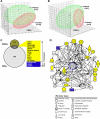Role of neutrophils in innate immunity: a systems biology-level approach
- PMID: 20836000
- PMCID: PMC3501127
- DOI: 10.1002/wsbm.32
Role of neutrophils in innate immunity: a systems biology-level approach
Abstract
The innate immune system is the first line of host defense against invading microorganisms. Polymorphonuclear leukocytes (PMNs or neutrophils) are the most abundant leukocyte in humans and essential to the innate immune response against invading pathogens. Compared with the acquired immune response, which requires time to develop and is dependent on previous interaction with specific microbes, the ability of neutrophils to kill microorganisms is immediate, non-specific, and not dependent on previous exposure to microorganisms. Historically, studies on PMN-pathogen interaction focused on the events leading to killing of microorganisms, such as recruitment/chemotaxis, transmigration, phagocytosis, and activation, whereas post-phagocytosis sequelae were infrequently considered. In addition, it was widely accepted that human neutrophils possessed limited capacity for new gene transcription and thus, relatively little biosynthetic capacity. This notion has changed dramatically within the past decade. Further, there is now more effort directed to understand the events occurring in PMNs after killing of microbes. Herein we review the systems biology-level approaches that have been used to gain an enhanced view of the role of neutrophils during host-pathogen interaction. We anticipate that these and future systems-level studies will ultimately provide information critical to our understanding, treatment, and control of diseases caused by pathogenic microorganisms.
Figures






References
-
- Homburg CH, Roos D. Apoptosis of neutrophils. Curr. Opin. Hematol. 1996 Jan;3(1):94–99. - PubMed
-
- Kasprisin DO, Harris MB. The role of RNA metabolism in polymorphonuclear leukocyte phagocytosis. J. Lab. Clin. Med. 1977 Jul;90(1):118–124. - PubMed
-
- Kasprisin DO, Harris MB. The role of protein synthesis in polymorphonuclear leukocyte phagocytosis II. Exp. Hematol. 1978 Aug;6(7):585–589. - PubMed
-
- Holland SM, DeLeo FR, Elloumi HZ, Hsu AP, Uzel G, Brodsky N, Freeman AF, Demidowich A, Davis J, Turner ML, Anderson VL, Darnell DN, Welch PA, Kuhns DB, Frucht DM, Malech HL, Gallin JI, Kobayashi SD, Whitney AR, Voyich JM, Musser JM, Woellner C, Schaffer AA, Puck JM, Grimbacher B. STAT3 Mutations in the Hyper-IgE Syndrome. N. Engl. J. Med. 2007 Sep;357(16):1608–1619. - PubMed
-
- Friedman AD. Transcriptional regulation of granulocyte and monocyte development. Oncogene. 2002 May;21(21):3377–3390. - PubMed
Publication types
MeSH terms
Grants and funding
LinkOut - more resources
Full Text Sources
Other Literature Sources
Miscellaneous

